Harrison Park (July 19)
We got off to a very early start, and reached the border by 10 a.m. (Often we have not even hitched up by then.) We were greeted by a customs agent with a classic Canadian accent punctuated by an “eh” at the end of every sentence. I felt welcomed home – especially as the entrance interview was primarily the agent expressing enthusiasm at learning we were heading up to Georgian Bay for a vacation.
Since we were making good time, we decided we could make it all the way to Owen Sound, a 5 hour drive from Barcelona.
My mother’s favorite aunt, Aunt Ida, owned a women’s clothing shop in Owen Sound. Because of this, in my childhood, we went there frequently to visit (and for my mother to shop for clothes). As well, the route passes through the green belt around Toronto that was the destination of many family and friends picnic, beach, hiking and tobogganing trips. As a result, most of the route was a nostalgia trip for me as we passed so many parks and towns whose names I knew well (although after 45 years, I doubt I would recall what these places look like, even without the changes time has brought).
Once we left Hwy 407, most of the trip was on Hwy 10, a very secondary road, which was mostly one lane in each direction. However, we were always behind vehicles moving more slowly than we would have, which I think eased Chuck’s usual worry that we hold up traffic. In any case, I won’t say the drive was easy (Chuck was doing the work) but it was not unduly stressful.
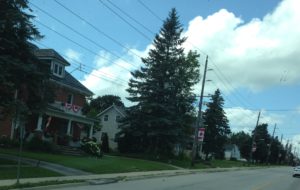 In my childhood, we used to make fun of the way that Americans put flags everywhere. No more. Perhaps it was due to the 150 year anniversary of Canada, but there were flags everywhere – on fence posts, front doors, pick-up trucks, and most notably, taking the place of the traditional hanging baskets of flowers on the main street lampposts of most of the small towns we passed through. A single small town yielded more Canadian flags than I used to see in a year – and that includes 1967, Canada’s centennial and the year that the maple leaf flag was adopted.
In my childhood, we used to make fun of the way that Americans put flags everywhere. No more. Perhaps it was due to the 150 year anniversary of Canada, but there were flags everywhere – on fence posts, front doors, pick-up trucks, and most notably, taking the place of the traditional hanging baskets of flowers on the main street lampposts of most of the small towns we passed through. A single small town yielded more Canadian flags than I used to see in a year – and that includes 1967, Canada’s centennial and the year that the maple leaf flag was adopted.
Most of the route is through farm country – primarily corn and rapeseed (Canola). The latter looks like (and is related to) wild mustard and is used for cooking oil, animal feed, biofuel, and lubricants. Another local farm product is power – there are many wind farms just off the highway.
Owen Sound has two attractions for us: My cousin Stephen and his wife Elaine, with whom we are close, still live there. And it is at the base of the Bruce Peninsula, one of the beautiful hiking and wilderness spots in the Northeast. N
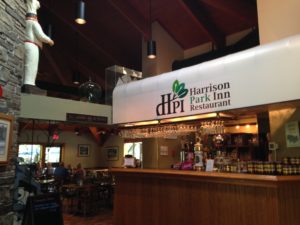 Owen Sound has a lovely civic park, Harrison Park, that has RV sites. We pulled in beside the Sydenham River, and near Weaver Creek, both of which flow through the park.
Owen Sound has a lovely civic park, Harrison Park, that has RV sites. We pulled in beside the Sydenham River, and near Weaver Creek, both of which flow through the park. 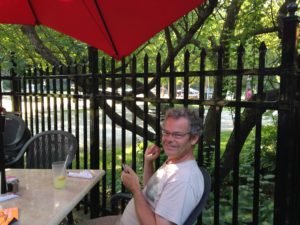 Among its many amenities, the park has a nice restaurant (which we visited for supper), a small bird sanctuary, a historical park celebrating Owen Sound’s historical significance as a final destination on the Underground Railroad, links to the Bruce Trail (which runs 890 km from Tobermory to Niagara Falls along the Niagara Escarpment, with 400 km of side trails) and a swimming pool.
Among its many amenities, the park has a nice restaurant (which we visited for supper), a small bird sanctuary, a historical park celebrating Owen Sound’s historical significance as a final destination on the Underground Railroad, links to the Bruce Trail (which runs 890 km from Tobermory to Niagara Falls along the Niagara Escarpment, with 400 km of side trails) and a swimming pool.
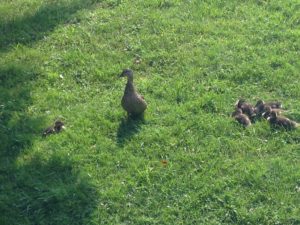
This large duck family was enjoying the bird sanctuary.
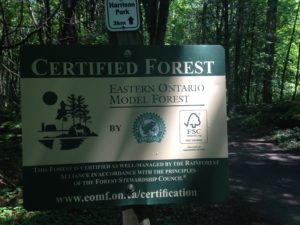 We thought it was obvious that we were in a forest and were surprised that certification would be needed to verify the fact. Actually the certification is for the management program for the forested lands.
We thought it was obvious that we were in a forest and were surprised that certification would be needed to verify the fact. Actually the certification is for the management program for the forested lands.
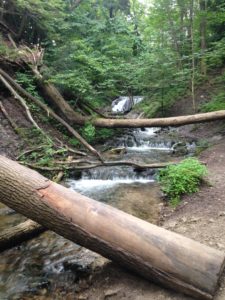
Walter’s Falls, a few yards (or meters) from the park at the top of Weaver Creek.
With our “just on time” scheduling, we were lucky that my cousins were in town and available to visit with us. After we set up and had dinner, I went with them to a “big band” concert at the Marine Rails Museum, while Chuck relaxed at home.
My childhood visits to Owen Sound were typical family visits. We spent most of our time at my aunt’s house (still standing, but now at the edge of a strip mall) and store. We occasionally went to Harrison Park for a walk. We sometimes went canoeing on the Sauble River, nearby, and we usually visited Inglis Falls, the largest waterfall in the area. As a result of this rather limited itinerary, I was not aware that Owen Sound is actually on a sound on Georgian Bay, close to many beautiful sand beaches and with great historical significance. (In fact, the link with the Underground Railroad was a shock to me.) Owen Sound is not a typical tourist destination, but I think we could happily spend a couple of weeks here without exhausting its tourism possibilities. This blog entry is rather long, due to the many things we enjoyed during our visit.
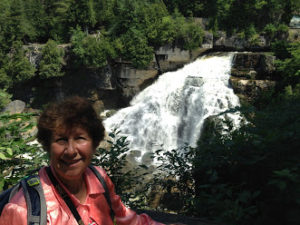 On Thursday, after a torrential thunderstorm, we met Stephen in town for coffee and then went back to Harrison Park to hike. We took a branch path of the Bruce Trail to Inglis Falls, which was spectacular after the rain. It was a lovely walk through the woods and through Inglis Arboreteum – although a bit buggy in the damp weather.
On Thursday, after a torrential thunderstorm, we met Stephen in town for coffee and then went back to Harrison Park to hike. We took a branch path of the Bruce Trail to Inglis Falls, which was spectacular after the rain. It was a lovely walk through the woods and through Inglis Arboreteum – although a bit buggy in the damp weather.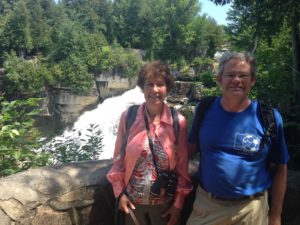
In the late afternoon, Stephen and Elaine picked us up and took us to the Owen Sound synagogue. I did not take any pictures, but they have a great website (https://bethezekielcanada.wordpress.com). This is the last small town synagogue in Canada, and has survived a reduction to 20 families at its low point. It now has 60 families, and appears to be quite vibrant. (I was aware that there was a small congregation in Owen Sound that met for services led by a member, but I did not know there was an actual synagogue.) The congregation was established in 1904, and the current building was purchased (from a church) in 1947. In 2001, a project was started to install stained glass windows celebrating some of the life stories of congregation members – these beautiful windows line the sanctuary and each is labelled with the inspiration for the design. ( These can be seen in here: https://bethezekielcanada.wordpress.com/artwork/our-windows/) In 2005, the synagogue courtyard was transformed into the Heritage Garden, a welcoming sitting space. In 2006, a section of the town cemetery was set aside for the congregation – prior to this, the dead were transported to the same cemetery in Toronto where my parents were buried. And in 2007, with the establishment of the Grey Roots Museum to document life in Grey County, the synagogue compiled a history of the Jewish community in Owen Sound, including an impressive book, a separate book just about the windows and (of course) a cookbook – all of which were gifted to us by the synagogue treasurer. This historical document is an impressive piece of work, and makes me think that a similar project for State College Jewish community would be worthwhile.
Following our synagogue tour, my cousins took us Port Elgin for dinner. This town, with a long beach on Lake Huron, is clearly thriving on tourism. It has a cute downtown with many restaurants. There is a town dock (of course) and on this day there was a car “cruise” featuring many old and fancy cars.
After dinner, we continued on to the marina to look at Lake Huron (which is high this year) and the boats. There is a bicycle and walking path that goes for miles along the lakeshore (and past the mansions there).
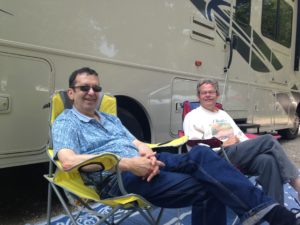 In the morning, Stephen showed up by bicycle for a quick visit. After he left, we considered whether to launch the kayaks.
In the morning, Stephen showed up by bicycle for a quick visit. After he left, we considered whether to launch the kayaks.
 With our campsite right beside the Sydenham River, it was hard to resist trying out our (fortunately indestructible) kayaks on the small rapids that run the length of the campground. In fact, a lot of kids were going down on inner tubes or inflatable rafts. We both bounced off several boulders, as the water was quite shallow and very fast. However, these kayaks really are indestructible and no harm was down.
With our campsite right beside the Sydenham River, it was hard to resist trying out our (fortunately indestructible) kayaks on the small rapids that run the length of the campground. In fact, a lot of kids were going down on inner tubes or inflatable rafts. We both bounced off several boulders, as the water was quite shallow and very fast. However, these kayaks really are indestructible and no harm was down.
At the downstream side of the park, the river opens up and is much calmer, with almost no current. There are a lot of big homes with beautiful gardens. There are also a huge number of Canada Geese and mallard ducks, and a few more interesting birds such as a green heron and many belted kingfishers. We were able to navigate the river down to a dam created for a grist mill, passing under a bridge that is practically downtown, and then return to the park. While it was not too much of a portage back to the campsite, we were lazy and loaded up the kayaks on our car.
We then headed into town to the Tom Thompson art gallery. Tom Thompson is one of my favorite Canadian painters. He spent a lot of time in Algonquin Park and other places where I used to camp. Most of his major works are in collections in Toronto, including the McMichael, which we visited earlier. The museum has many of his sketches and small studies, as well as work from local artists. One local work captured my interest because it echoed my experience. It shows a tourist looking at a bleak Algonquin vista and seeing the vibrant colors of a famous Thompson painting. Thompson’s paintings resonate with me partly because I have been there and seen what he saw, and partly because I see more because of his paintings (and the Group of Seven).
Another feature of the gallery is a set of plaques detailing some of the sad history of the First Peoples and their negotiations with the British government. As we all know, they kept being promised the use of their traditional lands in perpetuity – and then being forced off. Note that in Canada, Native Americans are referred to as First Peoples (since we use “native Canadian” to mean anyone born to Canadian parents).
One installation at the gallery we did not enjoy starts right at the entrance. You are invited to watch a short film about a diary that was discovered documenting Thompson’s friendship with a local man. It is intriguing because Thompson, an accomplished outdoorsman and canoeist, drowned on a solo trip to Algonquin and this diary seems to offer clues to his death. However, upon exiting the main exhibit, you learn that this diary is a work of fiction, and you are invited to view historical artifacts doctored to fit the fictional character’s life. I can see that this counts as art, but neither Chuck nor I enjoyed the misdirection.
After the art gallery, we walked downtown and conveniently (and accidentally) ran into Stephen. We then picked up Elaine and went out for Chinese food.
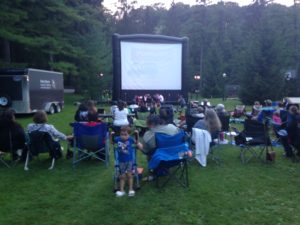 In the evening, the park had a First Nations event, featuring a drumming group and a film documentary about the first First Nations’ spelling bee team from Alberta. I cannot imagine the culture shock of the 3 children who won and participated in the national bee in Toronto. One of them made it into the final round – quite an amazing showing.
In the evening, the park had a First Nations event, featuring a drumming group and a film documentary about the first First Nations’ spelling bee team from Alberta. I cannot imagine the culture shock of the 3 children who won and participated in the national bee in Toronto. One of them made it into the final round – quite an amazing showing.
We decided to stay in Owen Sound for an additional day, but we unfortunately had to change campsites, which always takes a couple of hours. The good thing about it is that we ended up chatting with several of our neighbors. By the time we were set up and talked out, it was mid-afternoon. However, I really wanted to see the local history museum, Grey Roots, so off we went
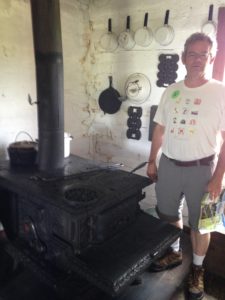 This is a history museum documenting primarily post-native settlement in the county, including a “village” made of up reconstructed buildings from the area – a small settler log cabin, a larger log cabin, a 1920’s house, and several other buildings including a barn, sawmill, garage (with old cars and trucks) and blacksmith shop. This iron stove was made in Brantford, the town where I was born.
This is a history museum documenting primarily post-native settlement in the county, including a “village” made of up reconstructed buildings from the area – a small settler log cabin, a larger log cabin, a 1920’s house, and several other buildings including a barn, sawmill, garage (with old cars and trucks) and blacksmith shop. This iron stove was made in Brantford, the town where I was born.
The most fun part of the village was the garage, due to the docent – a former mechanic somewhat older than us. 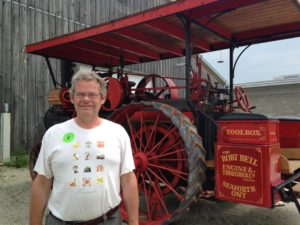 He was very knowledgeable about the older vehicles on display, and had worked on some of the newer ones. Many of the buildings had knowledgeable docents suitably dressed in period clothing, but it was special to learn from someone who had actually experienced at least some of the life he was explaining.
He was very knowledgeable about the older vehicles on display, and had worked on some of the newer ones. Many of the buildings had knowledgeable docents suitably dressed in period clothing, but it was special to learn from someone who had actually experienced at least some of the life he was explaining.
The opening exhibit in the main building was about Owen Sound’s less savory days as Canada’s “Sin City”. One intersection was known as “Damnation Square” for the pubs on each corner, while another was known as “Salvation Square” for its 4 churches. In 1905 the ” Women’s Christian Temperance Union” successfully lobbied for prohibition in the town. Amazingly, it was passed, and Owen Sound remained dry until 1972. Needless to say, this did nothing for the breweries and restaurants in town, but it did move the drinking to more discreet locations. (Maybe this is why Owen Sound is not a big tourist destination despite its many attractions.)
Another exhibit in the museum documents Owen Sound’s black community. Although the first blacks arrived as slaves, they were emancipated by the abolition of slavery in the British Empire in 1833. Meanwhile, back in the US, the Fugitive Slave Act of 1850 meant that fleeing slaves, and even free blacks, were at risk of being returned to slavery from so-called “free” states in the US. As a result, the “Underground Railway” extended into Canada, and Owen Sound was a terminus. Because of this, Owen Sound had a substantial African American population. This is not to say that there was no discrimination in Owen Sound, but many black citizens did rise to prominence. There is an annual Emancipation Festival that has been held since 1862 in Harrison Park.
Other exhibits in the museum documented various aspects of European settlement in the area. Oddly, settlement did not really begin until the 1830s, due to the heavily forested terrain and lack of roads. However, once a road was put in from Toronto, there were influxes of Irish and Scots, fleeing the potato famine, as well as Germans. These immigrants farmed as started small industries, such as grist and wood mills, breweries, etc some of which grew into large companies. However, in the past 20 years, many more companies have closed than have started in the area.
This is a small but very interesting museum.
We had a quiet dinner at Harrison park, eating our left-overs from Port Elgin and resting up before our next travel day.
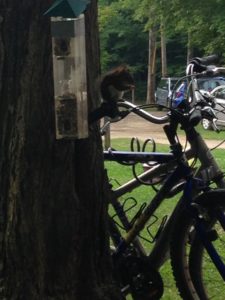 Our last day in Owen Sound, a red squirrel found our bird feeder. For some reason, only one bird, a blue jay, visited our feeding during our entire stay. Normally, having a squirrel raid the feeder would not thrill me. However, under the circumstances, watching this cute little guy enjoying breakfast at our expense was a real pleasure.
Our last day in Owen Sound, a red squirrel found our bird feeder. For some reason, only one bird, a blue jay, visited our feeding during our entire stay. Normally, having a squirrel raid the feeder would not thrill me. However, under the circumstances, watching this cute little guy enjoying breakfast at our expense was a real pleasure.
The last day in any place is our travel day. Usually on a travel day we do nothing but pack, travel and unpack. However, with only 1.5 hours to our next destination, we decided we could do a couple of things before we left. After a quick trip to the grocery store, we headed to the Marine Rail Museum.
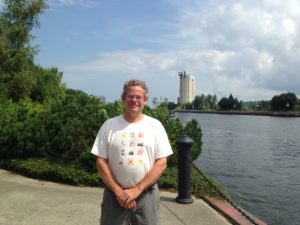 This little gem is in the old train station on Owen Sound (the bay) across the sound from the big grain elevator. It has a riverwalk with interpretive signs, and a small exhibit space in the station.
This little gem is in the old train station on Owen Sound (the bay) across the sound from the big grain elevator. It has a riverwalk with interpretive signs, and a small exhibit space in the station.
Owen Sound was once a major industrial and shipping center. With abundant water power and wood, the first settlers established grist and lumber mills, breweries, furniture factories and more. With access to the Great Lakes, it was a natural shipping center, particularly once a rail line was built to Toronto. For this reason, the Canadian Pacific Railway built a major grain elevator there, and extended the rail line for shipping grain. The harbor used to be among the busiest on the Great Lakes. (Hence there was plenty of traffic to take advantage of Damnation Square.) It was also a natural location for ship building. Another major industry was a foundry, which built large pieces of ship hardware, including propellers. With all this lumber at hand, Owen Sound was also home to a large company that made wooden toothpicks, which were exported around the world. (You would think that toothpicks would be a local industry.)
Many of these factories suffered multiple fires, but were rebuilt. Rebuilding after a disaster provides opportunities to modernize – particularly if insurance pays some of the costs. (Interesting factoid: In 2015 I visited one of the few iron factories in Germany that survived WWII. However, it did not survive the post-war recovery. The rebuilt factories were able to install modern manufacturing equipment, and once they were established they could outcompete this huge factory even with the large cost of reconstruction.)
Most of these industries are now defunct. After a fire at the grain elevators, CPR moved the grain terminus to another city on the lake (although a new elevator was built and dominates the skyline.)
The largest local industry is now health care, although there is Georgian College, which has a well-regarded marine engineering program. Oddly, one of the industries that remains is a printer, which produces, among other items, government forms. I say oddly, because one of the industries that has almost folded due to computing, is printing.
In any case, this little museum was definitely worth the visit.
These days, downtown Owen Sound is definitely suffering, with many closed store fronts. My aunt owned a ladieswear shop downtown, and even when I was a child she complained about competition from the “big box” stores establishing themselves on the edge of town. Of course, now there are even bigger “big box” stores, and the internet competition. Add to that the “greying” of the town, due to smaller families and younger people moving away, Store owners are retiring and not being bought out. However, as housing in southern Ontario has become ridiculously expensive, not just in Toronto but also in many of the small satellite towns, the town seems to be repopulating with retirees. It certainly has a lot to offer: close to beautiful beaches, many rivers, museums, hiking and proximity to the Bruce Trail. In fact, I would have to say that Owen Sound is a “hidden gem.” Much as I would like to see it stay hidden, it needs more tourist traffic and settlement to revitalize or be lost.
